 Reference images:
Reference images:
-
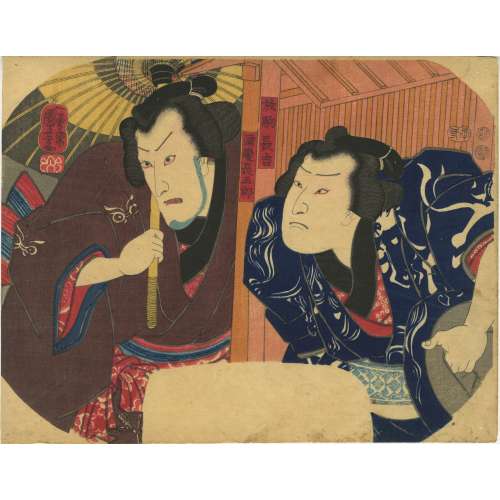 Artist: Utagawa Kuniyoshi [歌川 國芳] (1798 – 1861). Kabuki actors Ichikawa Danjūrō VIII and Arashi Rikan III as sumo wrestlers Nuregami Chōgorō (L) and Hanaregoma Chōkichi (R), respectively. Signed: Ichiyûsai Kuniyoshi ga (一勇斎 國芳 画) in a double gourd-shaped cartouche with Yoshi Kiri seal. Publisher: No seal. Date seal and double nanushi censor seal: Mera & Watanabe, 1852. Media: Fan print (uchiwa-e, 団扇絵), 231 x 295 mm. Theme: Nine-act drama (11 scenes) Futatsu Chōchō Kuruwa Nikki [双蝶々曲輪日記] (A Diary of Two Butterflies in the Pleasure Quarters) written by Takeda Izumo II, Namiki Senryū I, Miyoshi Shōraku (7/1749) as puppet play Bunraku [文楽], adopted for Kabuki theatre by Arashi San'emon IV. “The sumo wrestler Nuregami Chōgorō is trying to ransom the courtesan Azuma for Yogoro, in whose debt he stands. Hiraoka Goemon, who is at odds with Yogorō and Azuma, is the patron of the amateur wrestler Hanaregoma Chōkichi. Chōgorō purposely loses to Chōkichi and then asks the latter to stop Goemon's ransoming of Azuma; Chōkichi refuses, however, and they quarrel. Admonished for his dissipation by his sister Oseki, Chōkichi is going to commit ritual suicide (seppuku) as an apology for his behavior, but Chōgorō, who happens along just then, prevents him. The two men swear blood brotherhood. […] The confrontation between Chōgorō and Chōkichi in the Sumōba scene, acted in the exaggerated style called aragoto, is a major highlight of the work. The scene in Yohei's home, known as Hikimado, presents the unfolding of Kabuki's eternal conflict between duty and feelings, here represented by the act of opening the skylight (hikimado) to which Chōgorō is tied”. [Samuel L. Leiter. Kabuki Encyclopedia: an English-language adaptation of Kabuki Jiten. — Westport, CT; London: Greenwood Press, 1979, pp. 70-71]. See also James R. Brandon and Samuel L. Leiter. Kabuki plays on stage, vol. 1, pp. 234-258. — Honolulu: University of Hawai'i Press, 2002. Actors: Ichikawa Danjūrō VIII [市川団十郎] (Japanese, 1823 – 1854); other names: Ichikawa Ebizō VI, Ichikawa Shinnosuke II. Arashi Rikan III [嵐璃寛] (Japanese, 1812 – 1863); other names Arashi Tokusaburō III, Arashi Kicchō I, Onoe Wasaburō I. Another print in this collection with the same theme: SVJP-0331.2020.
Artist: Utagawa Kuniyoshi [歌川 國芳] (1798 – 1861). Kabuki actors Ichikawa Danjūrō VIII and Arashi Rikan III as sumo wrestlers Nuregami Chōgorō (L) and Hanaregoma Chōkichi (R), respectively. Signed: Ichiyûsai Kuniyoshi ga (一勇斎 國芳 画) in a double gourd-shaped cartouche with Yoshi Kiri seal. Publisher: No seal. Date seal and double nanushi censor seal: Mera & Watanabe, 1852. Media: Fan print (uchiwa-e, 団扇絵), 231 x 295 mm. Theme: Nine-act drama (11 scenes) Futatsu Chōchō Kuruwa Nikki [双蝶々曲輪日記] (A Diary of Two Butterflies in the Pleasure Quarters) written by Takeda Izumo II, Namiki Senryū I, Miyoshi Shōraku (7/1749) as puppet play Bunraku [文楽], adopted for Kabuki theatre by Arashi San'emon IV. “The sumo wrestler Nuregami Chōgorō is trying to ransom the courtesan Azuma for Yogoro, in whose debt he stands. Hiraoka Goemon, who is at odds with Yogorō and Azuma, is the patron of the amateur wrestler Hanaregoma Chōkichi. Chōgorō purposely loses to Chōkichi and then asks the latter to stop Goemon's ransoming of Azuma; Chōkichi refuses, however, and they quarrel. Admonished for his dissipation by his sister Oseki, Chōkichi is going to commit ritual suicide (seppuku) as an apology for his behavior, but Chōgorō, who happens along just then, prevents him. The two men swear blood brotherhood. […] The confrontation between Chōgorō and Chōkichi in the Sumōba scene, acted in the exaggerated style called aragoto, is a major highlight of the work. The scene in Yohei's home, known as Hikimado, presents the unfolding of Kabuki's eternal conflict between duty and feelings, here represented by the act of opening the skylight (hikimado) to which Chōgorō is tied”. [Samuel L. Leiter. Kabuki Encyclopedia: an English-language adaptation of Kabuki Jiten. — Westport, CT; London: Greenwood Press, 1979, pp. 70-71]. See also James R. Brandon and Samuel L. Leiter. Kabuki plays on stage, vol. 1, pp. 234-258. — Honolulu: University of Hawai'i Press, 2002. Actors: Ichikawa Danjūrō VIII [市川団十郎] (Japanese, 1823 – 1854); other names: Ichikawa Ebizō VI, Ichikawa Shinnosuke II. Arashi Rikan III [嵐璃寛] (Japanese, 1812 – 1863); other names Arashi Tokusaburō III, Arashi Kicchō I, Onoe Wasaburō I. Another print in this collection with the same theme: SVJP-0331.2020. Reference images:
Reference images:
-
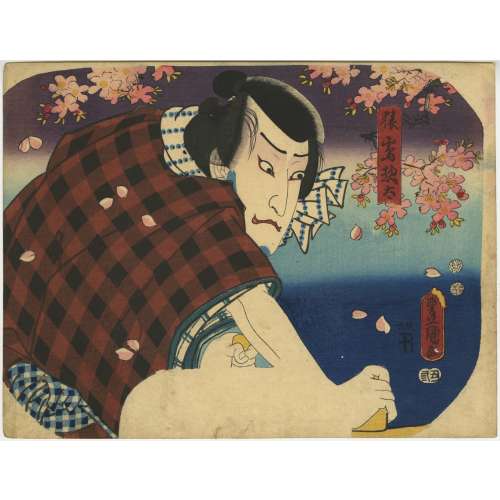 Kabuki actor Arashi Kichisaburō III [嵐吉三郎] as Sarushima Sōta [猿島惣太] in the play Hanamo Yoshida Iwao no Matsuwaka [花吉田岩尾松若] staged at Ichimura-za (市村座), theatre in Edo. Artist: Utagawa Kunisada, a.k.a. Toyokuni III (Japanese, 1786 – 1865) [歌川 国貞]. Publisher: Kojimaya Jūbei (Japanese, 1797-1869), seal: Hanmoto, Jū [板元, 十] (Marks 19-043 | 264c. Date seal and double nanushi censor seals Mera & Watanabe – 3rd month of Kaei 6 (1853). Signed: Toyokuni ga [豊国 画] in a red toshidama cartouche. Media: Fan print (uchiwa-e), 223 x 294 mm. Kabuki actor Arashi Kichisaburō III [嵐吉三郎] (Japanese, 1810 – 1864); other names: Arashi Daizaburō III, Arashi Kitsusaburō III Ref.: Art shop Ezoshi Ukiyoe new collection news, vol. 66, 2023.1 (Jan) # 30, p.8.
Kabuki actor Arashi Kichisaburō III [嵐吉三郎] as Sarushima Sōta [猿島惣太] in the play Hanamo Yoshida Iwao no Matsuwaka [花吉田岩尾松若] staged at Ichimura-za (市村座), theatre in Edo. Artist: Utagawa Kunisada, a.k.a. Toyokuni III (Japanese, 1786 – 1865) [歌川 国貞]. Publisher: Kojimaya Jūbei (Japanese, 1797-1869), seal: Hanmoto, Jū [板元, 十] (Marks 19-043 | 264c. Date seal and double nanushi censor seals Mera & Watanabe – 3rd month of Kaei 6 (1853). Signed: Toyokuni ga [豊国 画] in a red toshidama cartouche. Media: Fan print (uchiwa-e), 223 x 294 mm. Kabuki actor Arashi Kichisaburō III [嵐吉三郎] (Japanese, 1810 – 1864); other names: Arashi Daizaburō III, Arashi Kitsusaburō III Ref.: Art shop Ezoshi Ukiyoe new collection news, vol. 66, 2023.1 (Jan) # 30, p.8. -
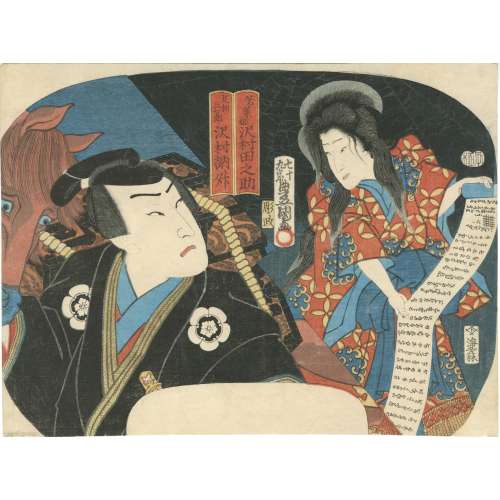 Artist: Utagawa Kunisada [歌川 国貞] a.k.a. Utagawa Toyokuni III [三代歌川豊国] (Japanese, 1786 – 1865). Artist signature: By the brush of the 79-year-old Toyokuni [七十九歳豊國画] (Nanajūkyū-sai Toyokuni ga). Publisher: Ebiya Rinnosuke [海老屋林之助] (Japanese, fl. c. 1832 – 1895); seal: ト/ 海老林 (to, Ebirin). Block carver: Matsushima Masakichi [松島政吉]; seal: carved by Masa [彫政] (Hori Masa). Combined date seal and kiwame censor seal: [子極] 1864 (Bunkyū 4/Genji 1). Media: Untrimmed fan print (uchiwa-e), 223 x 297 mm. Inscription in the cartouches: (R) Wakana-hime [若菜姫], Sawamura Tanosuke III [沢村田之助]; (L) Ashikaga Sanshichirō [足利三七郎], Sawamura Tosshō II [沢村訥升]. Play: Kinoene Soga Daikoku-bashira [甲子曽我大国柱], performed at the Morita theatre [森田座・守田座] (Morita-za) in 1864 (Bunkyū 4/Genji 1), 2nd month (see playbill at MFA-Boston Collection). Playwright: Muraoka Kōji II [村岡幸治]. Actors and Characters: Sawamura Tanosuke III [三代目沢村田之助] (Japanese, 1859 – 1878); other names: Shozan [曙山] (poetry name), Sawamura Yoshijirō I [初代沢村由次郎], here in the role of Princess Wakana [若菜姫] (Wakana-hime) (R). The story about Princess Wakana, Shiranui Monogatari, was written by Ryukatei Tanekazu [柳下亭種員] (Japanese, 1807 – 1858) and published as a 90-volume book of comics between 1849 and 1855. ...The tale revolves around the clash between the Kikuchi and Ōtomo clans. Princess Wakana’s father Ōtomo Sōrin [大友 宗麟] (1530 – 1587) was killed in a battle, and his spirit demanded revenge. To appease her late father's spirit, Princes Wakana acquired the power of the Earth Spider. She often appears in prints with a magic scroll, which helps her fight various enemies. Sawamura Tosshō II [二代目沢村訥升] (Japanese, 1854 – 1879); other names: Kōga [高賀] (poetry name), Sawamura Genpei II [二代目沢村源平], Sawamura Sōjūrō [澤村宗十郎], Suketakaya Takasuke IV [四代目助高屋高助], Sawamura Tosshi VI [六代目澤村訥子] (poetry name), here in the role of Ashikaga Sanshichirō [足利三七郎] (L) with a horse. According to Markus Sesko, the scene comes from the kabuki play Umakiri (馬斬り) by Tatsuoka Mansaku [辰岡万作] (17432 – 1809), which premiered in 1794. It was later assimilated into the Kabuki play Kozotte Mimasu Kuruwa no Datezome [襷廓三升伊達染], which was staged in the 1st lunar month of 1853 at the Nakamura-za. Umakiri is based on a Kyōgen play featured in Hideyoshi’s biography Taikōki [太閤記]. Its plot is that Ashikaga Sanchichirō Yoshitaka [足利三七郎義孝・義高], who is supposed to allude to Nobunaga’s son Oda Sanshichirō Nobutaka [織田三七郎信孝], attacks and kills a horse that is carrying 3,000 ryō (金三千両), money Mashiba Hisayoshi [真柴久吉] (an allusion to Hashiba Hideyoshi [羽柴秀吉]) had sent to be donated to a shrine on Mt. Kōya. The surrounding people try to catch him, but when they hear it is Yoshitaka who killed the horse, they fall to the ground and prostrate, and Yoshitaka leisurely leaves with the money. The plot is very simple, but Yoshitaka’s dashing appearance makes it very pleasing to watch. There are also prints that quote the main protagonist as Ashikaga Sanshichirō Harutaka [足利三七郎春高], and there is another title for the play, Sanzen-Ryō Kogane no Kurairi [三千両黄金蔵入] (Pocketing 3,000 ryō of gold). For reference, see also the BLOG. What these two characters are doing in one play remains a riddle. As Mr Graebner comments: "Most kabuki plays were only performed for one season (two months), and the books were lost. The playwrights have repeatedly used parts of plots from other plays, they have adopted characters, sometimes with the same or similar names. What can be found is the Kabuki Playbill (Tsuji banzuke) with cast and roles; the content is lost". Acknowledgements: Special thanks to Horst Graebner of the Kunisada Project and to Markus Sesko of The Metropolitan Museum, NY, for the analysis of the image and their invaluable contribution. For reference, see also:
Artist: Utagawa Kunisada [歌川 国貞] a.k.a. Utagawa Toyokuni III [三代歌川豊国] (Japanese, 1786 – 1865). Artist signature: By the brush of the 79-year-old Toyokuni [七十九歳豊國画] (Nanajūkyū-sai Toyokuni ga). Publisher: Ebiya Rinnosuke [海老屋林之助] (Japanese, fl. c. 1832 – 1895); seal: ト/ 海老林 (to, Ebirin). Block carver: Matsushima Masakichi [松島政吉]; seal: carved by Masa [彫政] (Hori Masa). Combined date seal and kiwame censor seal: [子極] 1864 (Bunkyū 4/Genji 1). Media: Untrimmed fan print (uchiwa-e), 223 x 297 mm. Inscription in the cartouches: (R) Wakana-hime [若菜姫], Sawamura Tanosuke III [沢村田之助]; (L) Ashikaga Sanshichirō [足利三七郎], Sawamura Tosshō II [沢村訥升]. Play: Kinoene Soga Daikoku-bashira [甲子曽我大国柱], performed at the Morita theatre [森田座・守田座] (Morita-za) in 1864 (Bunkyū 4/Genji 1), 2nd month (see playbill at MFA-Boston Collection). Playwright: Muraoka Kōji II [村岡幸治]. Actors and Characters: Sawamura Tanosuke III [三代目沢村田之助] (Japanese, 1859 – 1878); other names: Shozan [曙山] (poetry name), Sawamura Yoshijirō I [初代沢村由次郎], here in the role of Princess Wakana [若菜姫] (Wakana-hime) (R). The story about Princess Wakana, Shiranui Monogatari, was written by Ryukatei Tanekazu [柳下亭種員] (Japanese, 1807 – 1858) and published as a 90-volume book of comics between 1849 and 1855. ...The tale revolves around the clash between the Kikuchi and Ōtomo clans. Princess Wakana’s father Ōtomo Sōrin [大友 宗麟] (1530 – 1587) was killed in a battle, and his spirit demanded revenge. To appease her late father's spirit, Princes Wakana acquired the power of the Earth Spider. She often appears in prints with a magic scroll, which helps her fight various enemies. Sawamura Tosshō II [二代目沢村訥升] (Japanese, 1854 – 1879); other names: Kōga [高賀] (poetry name), Sawamura Genpei II [二代目沢村源平], Sawamura Sōjūrō [澤村宗十郎], Suketakaya Takasuke IV [四代目助高屋高助], Sawamura Tosshi VI [六代目澤村訥子] (poetry name), here in the role of Ashikaga Sanshichirō [足利三七郎] (L) with a horse. According to Markus Sesko, the scene comes from the kabuki play Umakiri (馬斬り) by Tatsuoka Mansaku [辰岡万作] (17432 – 1809), which premiered in 1794. It was later assimilated into the Kabuki play Kozotte Mimasu Kuruwa no Datezome [襷廓三升伊達染], which was staged in the 1st lunar month of 1853 at the Nakamura-za. Umakiri is based on a Kyōgen play featured in Hideyoshi’s biography Taikōki [太閤記]. Its plot is that Ashikaga Sanchichirō Yoshitaka [足利三七郎義孝・義高], who is supposed to allude to Nobunaga’s son Oda Sanshichirō Nobutaka [織田三七郎信孝], attacks and kills a horse that is carrying 3,000 ryō (金三千両), money Mashiba Hisayoshi [真柴久吉] (an allusion to Hashiba Hideyoshi [羽柴秀吉]) had sent to be donated to a shrine on Mt. Kōya. The surrounding people try to catch him, but when they hear it is Yoshitaka who killed the horse, they fall to the ground and prostrate, and Yoshitaka leisurely leaves with the money. The plot is very simple, but Yoshitaka’s dashing appearance makes it very pleasing to watch. There are also prints that quote the main protagonist as Ashikaga Sanshichirō Harutaka [足利三七郎春高], and there is another title for the play, Sanzen-Ryō Kogane no Kurairi [三千両黄金蔵入] (Pocketing 3,000 ryō of gold). For reference, see also the BLOG. What these two characters are doing in one play remains a riddle. As Mr Graebner comments: "Most kabuki plays were only performed for one season (two months), and the books were lost. The playwrights have repeatedly used parts of plots from other plays, they have adopted characters, sometimes with the same or similar names. What can be found is the Kabuki Playbill (Tsuji banzuke) with cast and roles; the content is lost". Acknowledgements: Special thanks to Horst Graebner of the Kunisada Project and to Markus Sesko of The Metropolitan Museum, NY, for the analysis of the image and their invaluable contribution. For reference, see also: -
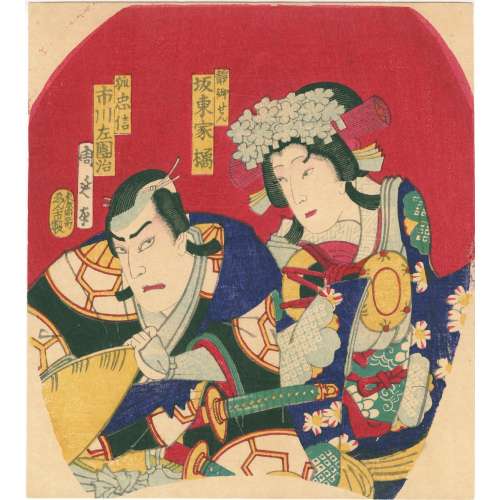 Artist: Toyohara Chikanobu [豊原周延] (Japanese, 1838 – 1912) Signed: Chikanobu ga [周延画] Publisher: [ 東京掘江町] Tokyo Horiemachi | [えん市製] Enshi-sei. Media: Fan print (uchiwa-e, 団扇絵), 192 x 172 mm. Actors: Female: Bandō Kakitsu I in the role of Shizuka Gozen [静御前]. Male: Ichikawa Sadanji I in the role of Kitsune Tadanobu [狐忠信], a.k.a. Satō Tadanobu [佐藤 忠信]. Bandō Kakitsu I [初代 坂東 家橘] (Japanese, 1847 – 1893); other names: Ichimura Kakitsu V, Ichimura Uzaemon XIV, Ichimura Kakitsu V, Ichimura Uzaemon XIV, Ichimura Takematsu III. Ichikawa Sadanji I [市川左団次] (Japanese, 1842 – 1904); other names: Ichikawa Shōjaku I, Ichikawa Koyone, Ichikawa Tatsuzō.
Artist: Toyohara Chikanobu [豊原周延] (Japanese, 1838 – 1912) Signed: Chikanobu ga [周延画] Publisher: [ 東京掘江町] Tokyo Horiemachi | [えん市製] Enshi-sei. Media: Fan print (uchiwa-e, 団扇絵), 192 x 172 mm. Actors: Female: Bandō Kakitsu I in the role of Shizuka Gozen [静御前]. Male: Ichikawa Sadanji I in the role of Kitsune Tadanobu [狐忠信], a.k.a. Satō Tadanobu [佐藤 忠信]. Bandō Kakitsu I [初代 坂東 家橘] (Japanese, 1847 – 1893); other names: Ichimura Kakitsu V, Ichimura Uzaemon XIV, Ichimura Kakitsu V, Ichimura Uzaemon XIV, Ichimura Takematsu III. Ichikawa Sadanji I [市川左団次] (Japanese, 1842 – 1904); other names: Ichikawa Shōjaku I, Ichikawa Koyone, Ichikawa Tatsuzō. -
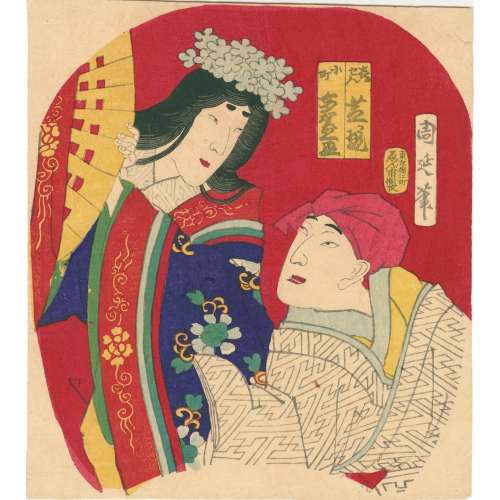 Artist: Toyohara Chikanobu [豊原周延] (Japanese, 1838 – 1912) Signed: Chikanobu hitsu [周延筆] Publisher: [ 東京掘江町] Tokyo Horiemachi | [えん市製] Enshi-sei. Media: Fan print (uchiwa-e, 団扇絵), 192 x 172 mm. Possibly Iwai Kumesaburō IV [岩井粂三郎] (1856 – 1886) a.k.a. Iwai Hisajirō III [岩井久次郎] in the role of Ono no Komachi [小野乃小町] and Nakamura Shikan IV [中村芝翫] in the role of Kisen Hōshi [喜せん法師]. Play: The Six Immortal Poets in Colorful Guises [六歌仙体綵] (Rokkasen Sugata no irodori). Inscription: Left: Kisen [喜せん] | Shikan [芝翫] Right: Komachi [小町] | Kumesaburō [粂三郎]. Actors: Iwai Kumesaburō IV [岩井粂三郎] (1856 – 1886) a.k.a. Iwai Hisajirō III [岩井久次郎]. Nakamura Shikan IV [中村芝翫] (Japanese, 1831 – 1899); other names: Nakamura Fukusuke I [中村福助], Nakamura Masanosuke I, Nakamura Komasaburō, Nakamura Tamatarō I.
Artist: Toyohara Chikanobu [豊原周延] (Japanese, 1838 – 1912) Signed: Chikanobu hitsu [周延筆] Publisher: [ 東京掘江町] Tokyo Horiemachi | [えん市製] Enshi-sei. Media: Fan print (uchiwa-e, 団扇絵), 192 x 172 mm. Possibly Iwai Kumesaburō IV [岩井粂三郎] (1856 – 1886) a.k.a. Iwai Hisajirō III [岩井久次郎] in the role of Ono no Komachi [小野乃小町] and Nakamura Shikan IV [中村芝翫] in the role of Kisen Hōshi [喜せん法師]. Play: The Six Immortal Poets in Colorful Guises [六歌仙体綵] (Rokkasen Sugata no irodori). Inscription: Left: Kisen [喜せん] | Shikan [芝翫] Right: Komachi [小町] | Kumesaburō [粂三郎]. Actors: Iwai Kumesaburō IV [岩井粂三郎] (1856 – 1886) a.k.a. Iwai Hisajirō III [岩井久次郎]. Nakamura Shikan IV [中村芝翫] (Japanese, 1831 – 1899); other names: Nakamura Fukusuke I [中村福助], Nakamura Masanosuke I, Nakamura Komasaburō, Nakamura Tamatarō I. -
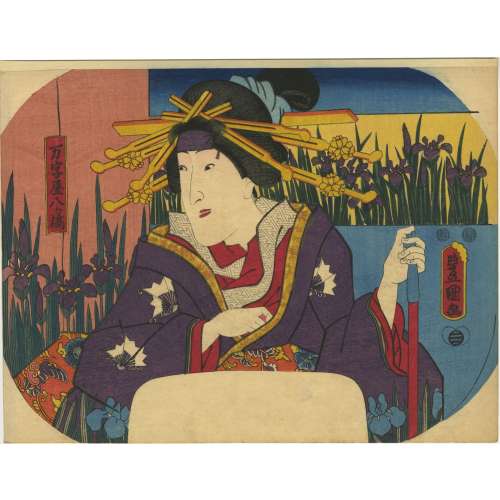 Artist: Utagawa Kunisada [歌川 国貞]; a.k.a. Utagawa Toyokuni III [三代歌川豊国] (Japanese, 1786 – 1865). Signed: Toyokuni ga [豊国 画] in a red toshidama cartouche. Publisher: Ibaya Senzaburō [伊場屋仙三郎] (Japanese, fl. C. 1845 – 1847), seal: San [三] (Marks 11-001 | 127c). Block carver: Matsushima Fusajirō [松嶋房次郎] (Japanese, fl. 1843 – 1850); seal [彫工房] – Hori kō Fusa (Gordon Friese № 134). Double nanushi censor seal: Kunigasa & Watanabe (1849-50). Actor: Iwai Hanshirō VIII [岩井半四郎] (Japanese, 1829 – 1882); other names: Iwai Shijaku II, Iwai Kumesaburō III [岩井粂三郎], Iwai Hisajirō II. Play: Yukari no Hana Iro mo Yoshiwara [紫花色吉原], performed at the Kawarazaki Theater (Edo) from the 5th day of the 5th lunar month of Kaei 3 (1850) (see Kabuki Playbill at MFA (Boston) № 11.27996).
Artist: Utagawa Kunisada [歌川 国貞]; a.k.a. Utagawa Toyokuni III [三代歌川豊国] (Japanese, 1786 – 1865). Signed: Toyokuni ga [豊国 画] in a red toshidama cartouche. Publisher: Ibaya Senzaburō [伊場屋仙三郎] (Japanese, fl. C. 1845 – 1847), seal: San [三] (Marks 11-001 | 127c). Block carver: Matsushima Fusajirō [松嶋房次郎] (Japanese, fl. 1843 – 1850); seal [彫工房] – Hori kō Fusa (Gordon Friese № 134). Double nanushi censor seal: Kunigasa & Watanabe (1849-50). Actor: Iwai Hanshirō VIII [岩井半四郎] (Japanese, 1829 – 1882); other names: Iwai Shijaku II, Iwai Kumesaburō III [岩井粂三郎], Iwai Hisajirō II. Play: Yukari no Hana Iro mo Yoshiwara [紫花色吉原], performed at the Kawarazaki Theater (Edo) from the 5th day of the 5th lunar month of Kaei 3 (1850) (see Kabuki Playbill at MFA (Boston) № 11.27996). A famous Yoshiwara courtesan named Manjiya Yatsuhashi [万字屋 八ツ橋] was killed by a provincial commoner Sano Jirōzaemon [佐野次郎左衛門] (on the second sheet of the pair):
A famous Yoshiwara courtesan named Manjiya Yatsuhashi [万字屋 八ツ橋] was killed by a provincial commoner Sano Jirōzaemon [佐野次郎左衛門] (on the second sheet of the pair):
Another Kunisada's print with the same characters in the same play and same performance can be seen at MFA (Boston) № 11.40190.
SVJP-0298.2019: Ichikawa Ebizō V as Sano Jirōzaemon.

SVJP-0297.2019: Iwai Kumesaburō III as Manjiya Yatsuhashi
 One more example can be seen in the two upper images at Waseda University Cultural Resources Database, № 006-2707:
One more example can be seen in the two upper images at Waseda University Cultural Resources Database, № 006-2707:

-
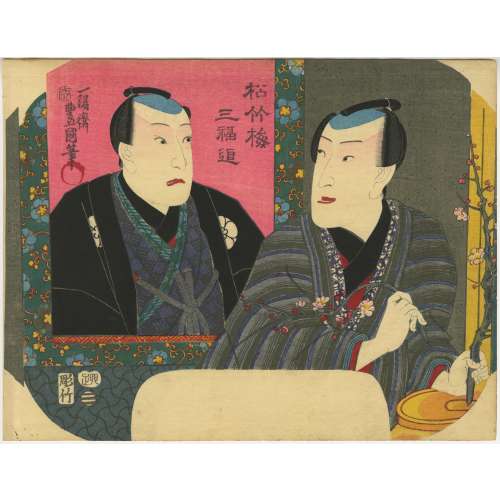 Artist: Utagawa Kunisada [歌川 国貞] a.k.a. Utagawa Toyokuni III [三代歌川豊国] (Japanese, 1786 – 1865). Signed: Ichiyōsai Toyokuni hitsu [一陽斎豊国筆]. Inscriptions: [松竹梅] Shochikubai = pine (matsu, 松), bamboo (take, 竹), and plum (ume, 梅) – an auspicious grouping known as "The Three Friends of Winter"; [三福追] (Sanpuku tsui) – the three delights, or pleasures. Date seal and aratame censor seal: Ansei 2, 1st month (1855). Publisher: Ibaya Senzaburō [伊場屋仙三郎] (Japanese, c. 1815 – 1869). Block carver: Yokokawa Takejirō [横川竹二郎] (Japanese, fl. 1845 – 1863); seal: Hori Take [彫竹]. Kabuki actor Nakamura Shikan IV [中村芝翫] (Nakamura Fukusuke I [中村福助], Nakamura Masanosuke I, Nakamura Komasaburō, Nakamura Tamatarō I, Japanese, 1831 – 1899) arranging a branch of blossoming plum to the memorial portrait of his predecessor Nakamura Utaemon IV [中村歌右衛門] (Nakamura Shikan II, Nakamura Tsurusuke I, Nakamura Tōtarō, Japanese, 1796 – 1852); the latter is dressed in a black robe adorned with a mokkō-crest (mon) of white plum blossom, the hanging scroll border decorated with arabesque and plum blossoms. Actors identified by Horst Graebner. Two fan prints from this series in Varshavsky Collection:
Artist: Utagawa Kunisada [歌川 国貞] a.k.a. Utagawa Toyokuni III [三代歌川豊国] (Japanese, 1786 – 1865). Signed: Ichiyōsai Toyokuni hitsu [一陽斎豊国筆]. Inscriptions: [松竹梅] Shochikubai = pine (matsu, 松), bamboo (take, 竹), and plum (ume, 梅) – an auspicious grouping known as "The Three Friends of Winter"; [三福追] (Sanpuku tsui) – the three delights, or pleasures. Date seal and aratame censor seal: Ansei 2, 1st month (1855). Publisher: Ibaya Senzaburō [伊場屋仙三郎] (Japanese, c. 1815 – 1869). Block carver: Yokokawa Takejirō [横川竹二郎] (Japanese, fl. 1845 – 1863); seal: Hori Take [彫竹]. Kabuki actor Nakamura Shikan IV [中村芝翫] (Nakamura Fukusuke I [中村福助], Nakamura Masanosuke I, Nakamura Komasaburō, Nakamura Tamatarō I, Japanese, 1831 – 1899) arranging a branch of blossoming plum to the memorial portrait of his predecessor Nakamura Utaemon IV [中村歌右衛門] (Nakamura Shikan II, Nakamura Tsurusuke I, Nakamura Tōtarō, Japanese, 1796 – 1852); the latter is dressed in a black robe adorned with a mokkō-crest (mon) of white plum blossom, the hanging scroll border decorated with arabesque and plum blossoms. Actors identified by Horst Graebner. Two fan prints from this series in Varshavsky Collection:
SVJP-0336.2021
-
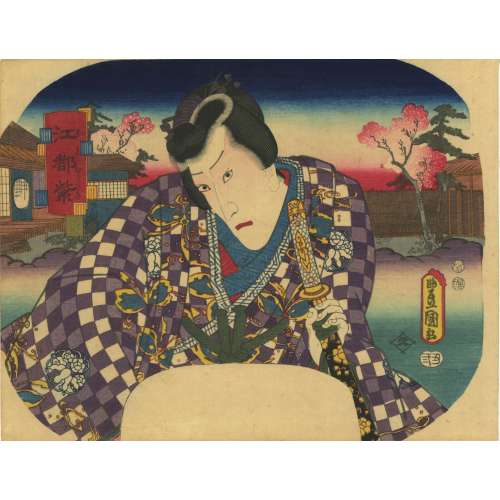 Utagawa Kunisada [歌川 国貞]; a.k.a. Utagawa Toyokuni III [三代歌川豊国] (Japanese, 1786 – 1865). Signed: Toyokuni ga [豊国 画] in a yellow toshidama cartouche. Publisher: Unknown, seal [久] Kyū (Japanese, fl. c. 1851 – 1861); (Marks 07-023 | U176a, possibly Sagamia Kyūzō). Date seal and double nanushi censor seals: Fuku & Muramatsu, Kaei 6, 2nd month (2/1853). Inscription in a red cartouche: (Purple of Edo // Purple of the Bay Capital) [江都むらさき] (Edo Murasaki), alluding to Murasaki Shikibu [紫 式部] (Japanese, c. 973/8 – c. 1014/31), the author of Genji Monogatari [源氏物語] (The Tale of Genji), a Heian period novel which was the source of a parody Nise Murasaki Inaka Genji [偐紫田舎源氏] (Fake Murasaki’s Rustic Genji) by Ryutei Tanehiko [柳亭種彦] (Japanese, 1783 – 1842). According to Horst Graebner: The actor is Ichikawa Danjūrō VIII. Ichikawa Danjūrō VIII [市川団十郎] (Japanese, 1823 – 1854); other names: Ichikawa Ebizō VI, Ichikawa Shinnosuke II. One of the series of Kunisada’s fan prints in this collection:
Utagawa Kunisada [歌川 国貞]; a.k.a. Utagawa Toyokuni III [三代歌川豊国] (Japanese, 1786 – 1865). Signed: Toyokuni ga [豊国 画] in a yellow toshidama cartouche. Publisher: Unknown, seal [久] Kyū (Japanese, fl. c. 1851 – 1861); (Marks 07-023 | U176a, possibly Sagamia Kyūzō). Date seal and double nanushi censor seals: Fuku & Muramatsu, Kaei 6, 2nd month (2/1853). Inscription in a red cartouche: (Purple of Edo // Purple of the Bay Capital) [江都むらさき] (Edo Murasaki), alluding to Murasaki Shikibu [紫 式部] (Japanese, c. 973/8 – c. 1014/31), the author of Genji Monogatari [源氏物語] (The Tale of Genji), a Heian period novel which was the source of a parody Nise Murasaki Inaka Genji [偐紫田舎源氏] (Fake Murasaki’s Rustic Genji) by Ryutei Tanehiko [柳亭種彦] (Japanese, 1783 – 1842). According to Horst Graebner: The actor is Ichikawa Danjūrō VIII. Ichikawa Danjūrō VIII [市川団十郎] (Japanese, 1823 – 1854); other names: Ichikawa Ebizō VI, Ichikawa Shinnosuke II. One of the series of Kunisada’s fan prints in this collection: -
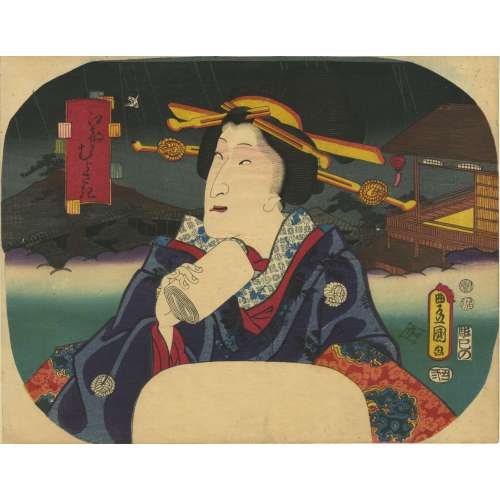 Utagawa Kunisada [歌川 国貞] a.k.a. Utagawa Toyokuni III [三代歌川豊国] (Japanese, 1786 – 1865). Signed: Toyokuni ga [豊国 画] in a yellow toshidama cartouche. Publisher: Unknown, seal [久] Kyū (Japanese, fl. c. 1851 – 1861); (Marks 07-023 | U176a, possibly Sagamia Kyūzō). Block carver: Koizumi Minokichi [小泉巳の吉] (Japanese, 1833 – 1906); seal: Hori Mino [彫已の] (Gordon Friese № 38). Date seal and double nanushi censor seals: Fuku & Muramatsu, Kaei 6, 2nd month (2/1853). Inscription in a red cartouche: (Purple of Edo // Purple of the Bay Capital) [江都むらさき] (Edo Murasaki), alluding to Murasaki Shikibu [紫 式部] (Japanese, c. 973/8 – c. 1014/31), the author of Genji Monogatari [源氏物語] (The Tale of Genji), a Heian period novel which was the source of a parody Nise Murasaki Inaka Genji [偐紫田舎源氏] (Fake Murasaki’s Rustic Genji) by Ryutei Tanehiko [柳亭種彦] (Japanese, 1783 – 1842). According to Horst Graebner: The actor is most probably Segawa Kikunojō V. Segawa Kikunojō V [瀬川菊之丞] (Japanese, 1802 – 1832); other names: Segawa Tamon I. One of the series of Kunisada's fan prints in this collection:
Utagawa Kunisada [歌川 国貞] a.k.a. Utagawa Toyokuni III [三代歌川豊国] (Japanese, 1786 – 1865). Signed: Toyokuni ga [豊国 画] in a yellow toshidama cartouche. Publisher: Unknown, seal [久] Kyū (Japanese, fl. c. 1851 – 1861); (Marks 07-023 | U176a, possibly Sagamia Kyūzō). Block carver: Koizumi Minokichi [小泉巳の吉] (Japanese, 1833 – 1906); seal: Hori Mino [彫已の] (Gordon Friese № 38). Date seal and double nanushi censor seals: Fuku & Muramatsu, Kaei 6, 2nd month (2/1853). Inscription in a red cartouche: (Purple of Edo // Purple of the Bay Capital) [江都むらさき] (Edo Murasaki), alluding to Murasaki Shikibu [紫 式部] (Japanese, c. 973/8 – c. 1014/31), the author of Genji Monogatari [源氏物語] (The Tale of Genji), a Heian period novel which was the source of a parody Nise Murasaki Inaka Genji [偐紫田舎源氏] (Fake Murasaki’s Rustic Genji) by Ryutei Tanehiko [柳亭種彦] (Japanese, 1783 – 1842). According to Horst Graebner: The actor is most probably Segawa Kikunojō V. Segawa Kikunojō V [瀬川菊之丞] (Japanese, 1802 – 1832); other names: Segawa Tamon I. One of the series of Kunisada's fan prints in this collection: -
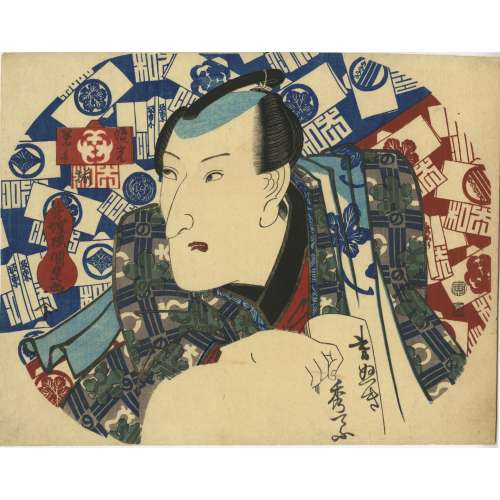 Artist: Utagawa Kunisada [歌川 国貞] a.k.a. Utagawa Toyokuni III [三代歌川豊国] (Japanese, 1786 – 1865). Signed: Kochoro Kuisada ga [香蝶楼国貞画] in a red double-gourd cartouche Publisher: Enshūya Matabei [遠州屋又兵衛] (Japanese, fl. c. 1768 – 1881). Series: Fashionable Youths [流行若手揃] (Ryuko Wakate Zoroi). Actor: Bandō Minosuke II [坂東蓑助] (Japanese, 1802 – 1863); other names: Morita Kan'ya XI, Bandô Mitsugorō IV. Date-kiwame seals: Bunsei 13 / Tenpō 1 (1830). One more print from the same series (See Waseda 201-2125); not in this collection: Segawa Kikunojō V [瀬川菊之丞] (Japanese, 1802 – 1832); other names: Segawa Tamon I.
Artist: Utagawa Kunisada [歌川 国貞] a.k.a. Utagawa Toyokuni III [三代歌川豊国] (Japanese, 1786 – 1865). Signed: Kochoro Kuisada ga [香蝶楼国貞画] in a red double-gourd cartouche Publisher: Enshūya Matabei [遠州屋又兵衛] (Japanese, fl. c. 1768 – 1881). Series: Fashionable Youths [流行若手揃] (Ryuko Wakate Zoroi). Actor: Bandō Minosuke II [坂東蓑助] (Japanese, 1802 – 1863); other names: Morita Kan'ya XI, Bandô Mitsugorō IV. Date-kiwame seals: Bunsei 13 / Tenpō 1 (1830). One more print from the same series (See Waseda 201-2125); not in this collection: Segawa Kikunojō V [瀬川菊之丞] (Japanese, 1802 – 1832); other names: Segawa Tamon I.
-
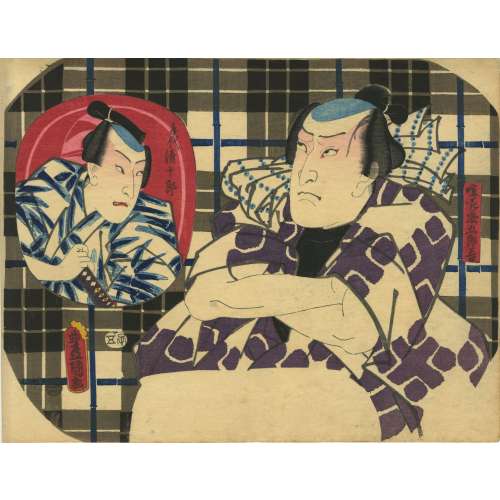 Artist: Utagawa Kunisada [歌川 国貞] a.k.a. Utagawa Toyokuni III [三代歌川豊国] (Japanese, 1786 – 1865). Publisher: Ibaya Senzaburō [伊場屋仙三郎] (Japanese, fl. C. 1845 – 1847). Date seal: [子五] Kaei 5, 5th month (5/1852). Signed: Toyokuni ga [豊国 画] in a red toshidama cartouche. Title: Actor Bandō Takesaburō I as clerk Seijūrō [手代清十郎] (left) and Actor Ichikawa Kodanji IV as Kenkaya Gorōkichi [喧嘩屋五郎吉] (right) in the play Musume ōgi tsui no tatehiki [娘扇一対侠贔屓 (むすめおうぎついのたてひき)] performed at the Nakamura theatre [中村座], in Edo (Tokyo). The playbill for this performance can be found at MFA (Boston) # 11.28042, 11.28285, 11.28286:
Artist: Utagawa Kunisada [歌川 国貞] a.k.a. Utagawa Toyokuni III [三代歌川豊国] (Japanese, 1786 – 1865). Publisher: Ibaya Senzaburō [伊場屋仙三郎] (Japanese, fl. C. 1845 – 1847). Date seal: [子五] Kaei 5, 5th month (5/1852). Signed: Toyokuni ga [豊国 画] in a red toshidama cartouche. Title: Actor Bandō Takesaburō I as clerk Seijūrō [手代清十郎] (left) and Actor Ichikawa Kodanji IV as Kenkaya Gorōkichi [喧嘩屋五郎吉] (right) in the play Musume ōgi tsui no tatehiki [娘扇一対侠贔屓 (むすめおうぎついのたてひき)] performed at the Nakamura theatre [中村座], in Edo (Tokyo). The playbill for this performance can be found at MFA (Boston) # 11.28042, 11.28285, 11.28286: Actors:
Bandō Takesaburō I (初代坂東竹三郎) (Japanese, 1832 – 1877); other names: Shinshi, Shinsui V, Bandō Hikosaburō V [五代目坂東彦三郎], Bandō Tsurunosuke I.
Ichikawa Kodanji IV [市川小團次] (Japanese, 1812 – 1866); other names: Ichikawa Yonejūrō I, Ichikawa Yonezō III, Ichikawa Eizō.
Actors:
Bandō Takesaburō I (初代坂東竹三郎) (Japanese, 1832 – 1877); other names: Shinshi, Shinsui V, Bandō Hikosaburō V [五代目坂東彦三郎], Bandō Tsurunosuke I.
Ichikawa Kodanji IV [市川小團次] (Japanese, 1812 – 1866); other names: Ichikawa Yonejūrō I, Ichikawa Yonezō III, Ichikawa Eizō.
Similar images were then used for the series Seven flourishing plants on lanterns for summer evenings [涼調珍盛の七草] (Suzumi chōchin sakari no nanakusa) published by Ibaya Senzaburō in 1852 (Kaei 5), 6th month.

Bandō Takesaburō I (carved by Yokokawa Takejirō): https://collections.mfa.org/objects/219360

Actor Ichikawa Kodanji IV (carved by Nakamura Tōkichi): https://collections.mfa.org/objects/477146.
-
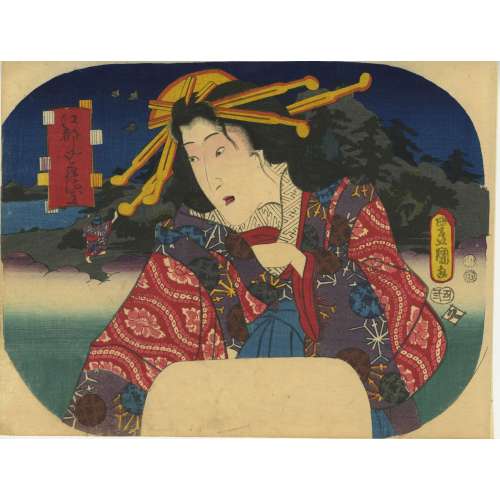 Utagawa Kunisada [歌川 国貞]; a.k.a. Utagawa Toyokuni III [三代歌川豊国] (Japanese, 1786 – 1865). Signed: Toyokuni ga [豊国 画] in a yellow toshidama cartouche. Publisher: Unknown, seal [久] Kyū (Japanese, fl. c. 1851 – 1861); (Marks 07-023 | U176a, possibly Sagamia Kyūzō). Date seal and double nanushi censor seals: Fuku & Muramatsu, Kaei 6, 2nd month (2/1853). Inscription in a red cartouche: (Purple of Edo // Purple of the Bay Capital) [江都むらさき] (Edo Murasaki), alluding to Murasaki Shikibu [紫 式部] (Japanese, c. 973/8 – c. 1014/31), the author of Genji Monogatari [源氏物語] (The Tale of Genji), a Heian period novel which was the source of a parody Nise Murasaki Inaka Genji [偐紫田舎源氏] (Fake Murasaki’s Rustic Genji) by Ryutei Tanehiko [柳亭種彦] (Japanese, 1783 – 1842). According to Horst Graebner: The actor is most probably Onoe Baikō IV [四代目尾上菊五郞] Onoe Kikugorō IV [四代目 尾上菊五郎] (Japanese, 1808 – 1860); other names: Onoe Baikō IV, Onoe Eizaburō III, Onoe Kikue, Nakamura Tatsuzō, Nakamura Kachō. One of the series of Kunisada's fan prints in this collection:
Utagawa Kunisada [歌川 国貞]; a.k.a. Utagawa Toyokuni III [三代歌川豊国] (Japanese, 1786 – 1865). Signed: Toyokuni ga [豊国 画] in a yellow toshidama cartouche. Publisher: Unknown, seal [久] Kyū (Japanese, fl. c. 1851 – 1861); (Marks 07-023 | U176a, possibly Sagamia Kyūzō). Date seal and double nanushi censor seals: Fuku & Muramatsu, Kaei 6, 2nd month (2/1853). Inscription in a red cartouche: (Purple of Edo // Purple of the Bay Capital) [江都むらさき] (Edo Murasaki), alluding to Murasaki Shikibu [紫 式部] (Japanese, c. 973/8 – c. 1014/31), the author of Genji Monogatari [源氏物語] (The Tale of Genji), a Heian period novel which was the source of a parody Nise Murasaki Inaka Genji [偐紫田舎源氏] (Fake Murasaki’s Rustic Genji) by Ryutei Tanehiko [柳亭種彦] (Japanese, 1783 – 1842). According to Horst Graebner: The actor is most probably Onoe Baikō IV [四代目尾上菊五郞] Onoe Kikugorō IV [四代目 尾上菊五郎] (Japanese, 1808 – 1860); other names: Onoe Baikō IV, Onoe Eizaburō III, Onoe Kikue, Nakamura Tatsuzō, Nakamura Kachō. One of the series of Kunisada's fan prints in this collection: -
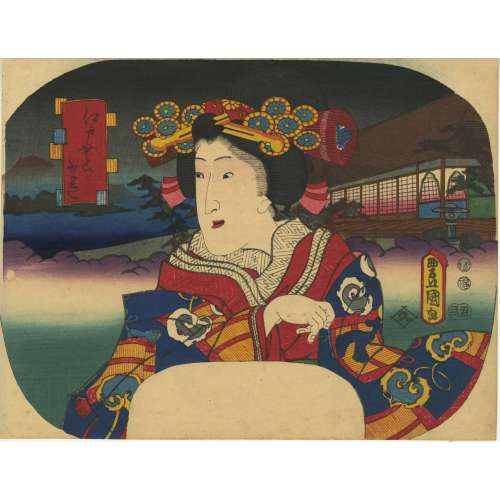 Utagawa Kunisada [歌川 国貞]; a.k.a. Utagawa Toyokuni III [三代歌川豊国] (Japanese, 1786 – 1865). Signed: Toyokuni ga [豊国 画] in a yellow toshidama cartouche. Publisher: Unknown, seal [久] Kyū (Japanese, fl. c. 1851 – 1861); (Marks 07-023 | U176a, possibly Sagamia Kyūzō). Date seal and double nanushi censor seals: Fuku & Muramatsu, Kaei 6, 2nd month (2/1853). Inscription in a red cartouche: Purple of Edo // Purple of the Bay Capital [江都むらさき] (Edo Murasaki), alluding to Murasaki Shikibu [紫 式部] (Japanese, c. 973/8 – c. 1014/31), the author of Genji Monogatari [源氏物語] (The Tale of Genji), a Heian period novel which was the source of a parody Nise Murasaki Inaka Genji [偐紫田舎源氏] (Fake Murasaki’s Rustic Genji) by Ryutei Tanehiko [柳亭種彦] (Japanese, 1783 – 1842). According to Horst Graebner: The actor is most probably Iwai Kumesaburō III. Iwai Hanshirō VIII [岩井半四郎] (Japanese, 1829 – 1882); other names: Iwai Shijaku II, Iwai Kumesaburō III [岩井粂三郎], Iwai Hisajirō II. One of the series of Kunisada's fan prints in this collection:
Utagawa Kunisada [歌川 国貞]; a.k.a. Utagawa Toyokuni III [三代歌川豊国] (Japanese, 1786 – 1865). Signed: Toyokuni ga [豊国 画] in a yellow toshidama cartouche. Publisher: Unknown, seal [久] Kyū (Japanese, fl. c. 1851 – 1861); (Marks 07-023 | U176a, possibly Sagamia Kyūzō). Date seal and double nanushi censor seals: Fuku & Muramatsu, Kaei 6, 2nd month (2/1853). Inscription in a red cartouche: Purple of Edo // Purple of the Bay Capital [江都むらさき] (Edo Murasaki), alluding to Murasaki Shikibu [紫 式部] (Japanese, c. 973/8 – c. 1014/31), the author of Genji Monogatari [源氏物語] (The Tale of Genji), a Heian period novel which was the source of a parody Nise Murasaki Inaka Genji [偐紫田舎源氏] (Fake Murasaki’s Rustic Genji) by Ryutei Tanehiko [柳亭種彦] (Japanese, 1783 – 1842). According to Horst Graebner: The actor is most probably Iwai Kumesaburō III. Iwai Hanshirō VIII [岩井半四郎] (Japanese, 1829 – 1882); other names: Iwai Shijaku II, Iwai Kumesaburō III [岩井粂三郎], Iwai Hisajirō II. One of the series of Kunisada's fan prints in this collection: -
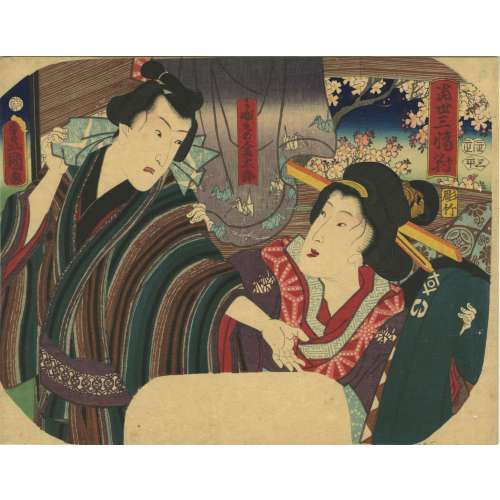 Utagawa Kunisada [歌川 国貞]; a.k.a. Utagawa Toyokuni III [三代歌川豊国] (Japanese, 1786 – 1865). Signed: Toyokuni ga [豊国 画] in a red toshidama cartouche. Publisher: Mikawaya Heiroku [三川屋平六] (Japanese, fl. c. 1848 – 1856); seal: Mihei [三平] (Marks 11-016 | 325a) Block carver: Yokokawa Takejirō [横川竹二郎] (Japanese, fl. 1845 – 1863), seal: 彫竹 – Hori Take. Date seal and aratame censor seal: [辰正] Ansei 3, 1st month (1856). Inscriptions: Right cartouche: Three good fortunes of the present day [当世三福対] (Tosei sambuku tsui) Center cartouche: Ubuge no Kintaro [産毛の金太郎] (うぶげのきんたろう) According to Horst Graebner, the play is Tomigaoka koi no Yamabiraki (or Tomioka Koi no Yamabiraki [富岡戀山開], according to kabuki21.com, common title Ninin Shinbē [二人新兵衛]); Kintarō might be Nakamura Fukusuke I [中村福助], the female role might be Mikuni Kojorō [三国小女郎] (or Mikuni no Kojorō). Nakamura Shikan IV [中村芝翫] (Japanese, 1831 – 1899); other names: Nakamura Fukusuke I, Nakamura Masanosuke I, Nakamura Komasaburō, Nakamura Tamatarō I.
Utagawa Kunisada [歌川 国貞]; a.k.a. Utagawa Toyokuni III [三代歌川豊国] (Japanese, 1786 – 1865). Signed: Toyokuni ga [豊国 画] in a red toshidama cartouche. Publisher: Mikawaya Heiroku [三川屋平六] (Japanese, fl. c. 1848 – 1856); seal: Mihei [三平] (Marks 11-016 | 325a) Block carver: Yokokawa Takejirō [横川竹二郎] (Japanese, fl. 1845 – 1863), seal: 彫竹 – Hori Take. Date seal and aratame censor seal: [辰正] Ansei 3, 1st month (1856). Inscriptions: Right cartouche: Three good fortunes of the present day [当世三福対] (Tosei sambuku tsui) Center cartouche: Ubuge no Kintaro [産毛の金太郎] (うぶげのきんたろう) According to Horst Graebner, the play is Tomigaoka koi no Yamabiraki (or Tomioka Koi no Yamabiraki [富岡戀山開], according to kabuki21.com, common title Ninin Shinbē [二人新兵衛]); Kintarō might be Nakamura Fukusuke I [中村福助], the female role might be Mikuni Kojorō [三国小女郎] (or Mikuni no Kojorō). Nakamura Shikan IV [中村芝翫] (Japanese, 1831 – 1899); other names: Nakamura Fukusuke I, Nakamura Masanosuke I, Nakamura Komasaburō, Nakamura Tamatarō I. -
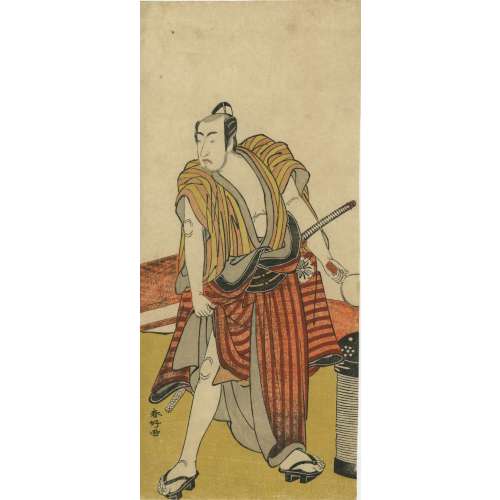 Artist: Katsukawa Shunkō [勝川 春好] (Japanese, 1743 – 1812).
Artist: Katsukawa Shunkō [勝川 春好] (Japanese, 1743 – 1812).Actor: Matsumoto Kōshirō IV [[松本幸四郎]; other names: Omegawa Kyōjūrō, Ichikawa Komazō II, Ichikawa Somegorô I, Ichikawa Takejūrō, Segawa Kinji, Segawa Kingo] (Japanese, 1737 – 1802).
Signed: Shunkō ga. Size: Hosoban; 14 x 33 cm. SOLD -
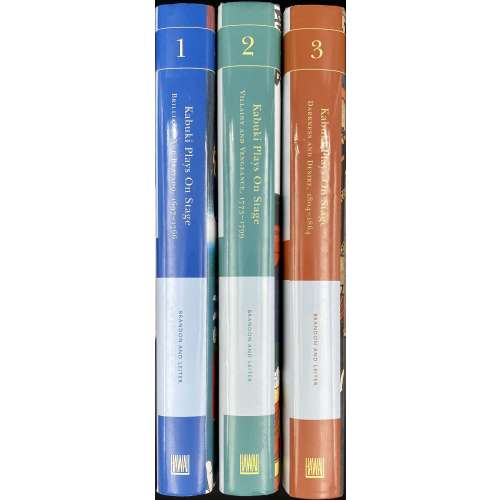 Three volumes, 26.2 x 18.6 cm each: Vol. 1: Kabuki plays on stage: Brilliance and Bravado, 1697-1766; pp.: [i-viii] ix-xiii [xiv blank], 1-391 [1 blank], total 203 leaves, ils. Blue buckram gilt-lettered on spine, pictorial DJ. Vol. 2: Kabuki plays on stage: Villainy and Vengeance, 1773-1799; pp.: [i-viii] ix-xiii [xiv blank], 1-413 [3 blank], total 215 leaves, ils. Green buckram gilt-lettered on spine, pictorial DJ. Vol. 3: Kabuki plays on stage: Darkness and Desire, 1804-1864; pp.: [i-viii] ix-xv [xvi blank], [1] 2-397 [3 blank], total 208 leaves, ils. Ochre buckram gilt-lettered on spine, pictorial DJ. (Vol. 4: Restoration and reform, 1872-1905 – absent for the reason of no interest in the covered period). Contributors: James Rodger Brandon (American, 1927 – 2015) Samuel L. Leiter (American, b. 1940)
Three volumes, 26.2 x 18.6 cm each: Vol. 1: Kabuki plays on stage: Brilliance and Bravado, 1697-1766; pp.: [i-viii] ix-xiii [xiv blank], 1-391 [1 blank], total 203 leaves, ils. Blue buckram gilt-lettered on spine, pictorial DJ. Vol. 2: Kabuki plays on stage: Villainy and Vengeance, 1773-1799; pp.: [i-viii] ix-xiii [xiv blank], 1-413 [3 blank], total 215 leaves, ils. Green buckram gilt-lettered on spine, pictorial DJ. Vol. 3: Kabuki plays on stage: Darkness and Desire, 1804-1864; pp.: [i-viii] ix-xv [xvi blank], [1] 2-397 [3 blank], total 208 leaves, ils. Ochre buckram gilt-lettered on spine, pictorial DJ. (Vol. 4: Restoration and reform, 1872-1905 – absent for the reason of no interest in the covered period). Contributors: James Rodger Brandon (American, 1927 – 2015) Samuel L. Leiter (American, b. 1940) -
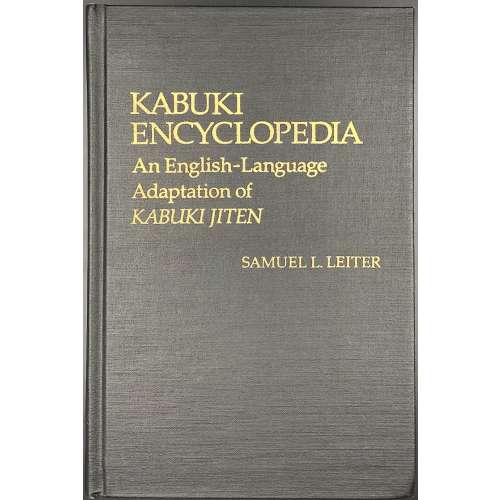 One volume 24.2 x 16.2 x 5.2 cm, in black cloth lettered in gilt to front cover and spine, pp.: i-vii] viii-xxxix [xl blank] [2] 3-572 [2], total 307 leaves, with b/w illustrations. Title-page: KABUKI | ENCYCLOPEDIA | An English-Language | Adaptation of | KABUKI JITEN | SAMUEL L. LEITER | {publisher’s device “GP”} | GREENWOOD PRESS | WESTPORT, CONNECTICUT • LONDON, ENGLAND || Author: Samuel L. Leiter (American, b. 1940)
One volume 24.2 x 16.2 x 5.2 cm, in black cloth lettered in gilt to front cover and spine, pp.: i-vii] viii-xxxix [xl blank] [2] 3-572 [2], total 307 leaves, with b/w illustrations. Title-page: KABUKI | ENCYCLOPEDIA | An English-Language | Adaptation of | KABUKI JITEN | SAMUEL L. LEITER | {publisher’s device “GP”} | GREENWOOD PRESS | WESTPORT, CONNECTICUT • LONDON, ENGLAND || Author: Samuel L. Leiter (American, b. 1940) -
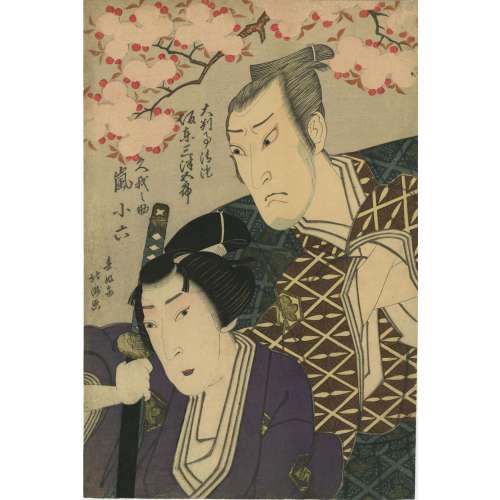 Bandō Mitsugorō III as Daihanji Kiyozumi and Arashi Koroku IV as Koganosuke in kabuki play Imoseyama, an example of womanly virtue (Imoseyama onna teikin). 大判事清澄 坂東三津五郎」(三代)・「久我之助 嵐小六」(四代) Artist: Shunkōsai Hokushū [春好斎北洲] (Japanese, fl. 1802 – 1832) Year: 1821 (3rd month). MFA description: “The Kabuki play Mount Imo and Mount Se: An Exemplary Tale of Womanly Virtue (Imoseyama onna teikin), originally based on a puppet play, is set in ancient Japan when the Soga clan served as regents to the emperor. Two children, Hinadori and Koganosuke, of rival court families, are held hostage under orders from the tyrant Soga no Iruka to ensure their families do not revolt. The children fall in love, but rather than create conflicts for their families they each vow to die by suicide. When the parents learn of their plans, they resolve to cooperate to overthrow Iruka. Here Koganosuke and his father Kiyozumi are shown; a companion sheet on the left would have shown Hinadori and her mother Sadaka.” The play Imoseyama, an example of womanly virtue (Imoseyama onna teikin), was staged at Osaka's Kado Shibai (Kadoza, Kado Gekijô, Kado no Shibai) from 3/1821. According to Herwig, it is the right sheet of a diptych (see below). MFA Accession number: 2011.128 Kabuki actors: Bandō Mitsugorō III [三代目 坂東 三津五郎] (Japanese, 1775 – 1831); other names: Bandō Minosuke I, Morita Kanjirô II, Bandō Mitahachi I, Bandō Minosuke I, Bandō Mitahachi I. Arashi Koroku IV [四代目嵐小六] (Japanese, 1783 – 1826)
Bandō Mitsugorō III as Daihanji Kiyozumi and Arashi Koroku IV as Koganosuke in kabuki play Imoseyama, an example of womanly virtue (Imoseyama onna teikin). 大判事清澄 坂東三津五郎」(三代)・「久我之助 嵐小六」(四代) Artist: Shunkōsai Hokushū [春好斎北洲] (Japanese, fl. 1802 – 1832) Year: 1821 (3rd month). MFA description: “The Kabuki play Mount Imo and Mount Se: An Exemplary Tale of Womanly Virtue (Imoseyama onna teikin), originally based on a puppet play, is set in ancient Japan when the Soga clan served as regents to the emperor. Two children, Hinadori and Koganosuke, of rival court families, are held hostage under orders from the tyrant Soga no Iruka to ensure their families do not revolt. The children fall in love, but rather than create conflicts for their families they each vow to die by suicide. When the parents learn of their plans, they resolve to cooperate to overthrow Iruka. Here Koganosuke and his father Kiyozumi are shown; a companion sheet on the left would have shown Hinadori and her mother Sadaka.” The play Imoseyama, an example of womanly virtue (Imoseyama onna teikin), was staged at Osaka's Kado Shibai (Kadoza, Kado Gekijô, Kado no Shibai) from 3/1821. According to Herwig, it is the right sheet of a diptych (see below). MFA Accession number: 2011.128 Kabuki actors: Bandō Mitsugorō III [三代目 坂東 三津五郎] (Japanese, 1775 – 1831); other names: Bandō Minosuke I, Morita Kanjirô II, Bandō Mitahachi I, Bandō Minosuke I, Bandō Mitahachi I. Arashi Koroku IV [四代目嵐小六] (Japanese, 1783 – 1826)
Ref.: [LIB-1197.2016] Arendie and Henk Herwig. Heroes of the kabuki stage: an introduction to kabuki with retellings of famous plays, illustrated by woodblock prints. — Amsterdam: Hotei Publishing, 2004; p. 72:
Ref: [LIB-2973.2022] Ukiyo-e: A journey through the Floating World / Exhibition catalogue (Japan, Jan-Jul 2014). — The Yomiuri Shimbun, 2014; № 358, p. 226. "Bandō Mitsugorō III as Grand arbiter Kiyosumi and Arashi Koroku IV as Koganosuke":











